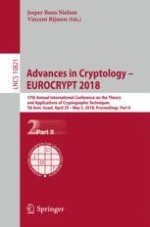The three volumes LNCS 10820, 10821, and 10822 constitute the thoroughly refereed proceedings of the 37th Annual International Conference on the Theory and Applications of Cryptographic Techniques, EUROCRYPT 2018, held in Tel Aviv, Israel, in April/May 2018.
The 69 full papers presented were carefully reviewed and selected from 294 submissions. The papers are organized into the following topical sections: foundations; lattices; random oracle model; fully homomorphic encryption; permutations; galois counter mode; attribute-based encryption; secret sharing; blockchain; multi-collision resistance; signatures; private simultaneous messages; masking; theoretical multiparty computation; obfuscation; symmetric cryptanalysis; zero-knowledge; implementing multiparty computation; non-interactive zero-knowledge; anonymous communication; isogeny; leakage; key exchange; quantum; non-malleable codes; and provable symmetric cyptography.
